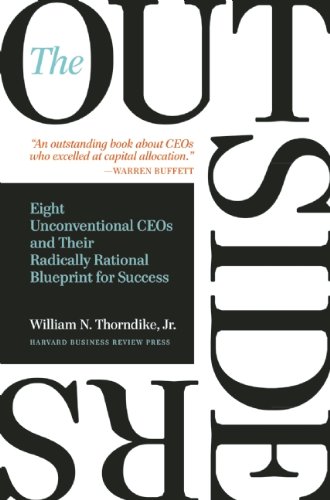

This article is an excerpt from the Shortform summary of "The Outsiders" by William N. Thorndike, Jr. Shortform has the world's best summaries of books you should be reading.
Like this article? Sign up for a free trial here .
How did an inexperienced executive like Katharine Graham take the Washington Post from a local newspaper to a nationally-renowned publication and high-value company?
Katharine Graham, Washington Post CEO from 1963-1993, took over management when her husband committed suicide. She first spent several years learning the ropes. She became a powerful CEO and smart decision-maker, and she made sure she had the best staff and advisers to make the company the powerhouse it is today.
Katharine Graham at the Washington Post: Smart Acquisitions and Decisions
An inexperienced executive, Katharine Graham hadn’t worked for 20 years when she took the CEO role. But through wise decisions around both editorial and business, the help of strong executives, and a key advisor by the name of Warren Buffett, she led the Post to be the most successful newspaper company of its class. Katharine Graham, Washington Post CEO, became one of the best-known CEOs and media leaders of all time.
In 1974, a relative unknown began buying stock in the Post, ending with 13% ownership. His name was Warren Buffett. While her board counseled her to avoid the unknown, she met with him and found his advice indispensable, and she invited him to join the board. He would prove to be vital throughout Graham’s tenure, advising her around capital allocations.
For example, in 1975 the Post faced a workers strike from paper printers. Buffett advised Graham to repurchase Post shares, given their low prices. She repurchased 40% of Post shares, an unusual move that her competitors didn’t follow.
In 1981, Katharine Graham, Washington Post CEO, hired a strong COO, Dick Simmons. Like other COOs for the outsider CEOs in this book, Simmons carried operational excellence to the Post’s business units, increasing margins improving compensation structure.
During the 1980s, the newspaper industry went on an acquisition spree, bidding up prices aggressively. Graham didn’t participate, finding the assets overpriced. Instead, they looked to businesses outside media, acquiring companies in telephone, test preparation (Kaplan), and cable television (from Capital Cities). Each of these would both rise in value and provide a valuable counterweight to the newspaper business as it declined due to the Internet.
As the early 1990s approached with a recession, the Post became acquisitive while its competitors sat back, over-saddled with debt. Under CEO Katharine Graham, the Washington Post purchased companies at significant discounts in cable television, TV, and education.
Staff Shakeups
In 1967, she made an unconventional staffing choice—she replaced her veteran editor-in-chief with a young firebrand, Ben Bradlee. Changing from a veteran to a newcomer was an odd choice, but CEO Katharine Graham of the Washington Post believed she needed someone with a better grasp of the 1960s zeitgeist. Bradlee’s energy would prove vital in raising the profile of the Post’s newsroom in its stories.
In 1971 and 1972, Katharine Graham’s Washington Post clashed with the Nixon administration over stories critical of the presidency. This included the breakthrough investigation of the Watergate scandal. Despite the Nixon administration’s threats to impede the Post with regulatory scrutiny, Katharine Graham’s Washington Post pushed forward and published the stories. These elevated the stature of the Washington Post, putting it on equal footing with the New York Times, and increasing its potential stock value.
Financial Allocation
As with the other outsider CEOs, Katharine Graham’s choices around how to get money and how to spend it caused the Post’s outperformance:
- For Katharine Graham, Washington Post’s main source of capital was cash flow, generated when the Post lost its main competition in Washington and when her COO Simmons made business units more efficient. Unlike other CEOs mentioned thus far, Graham rarely sold Post businesses and did not regularly use debt.
- She rarely paid dividends, a rarity among newspaper companies, which were owned by families who depended on dividend income.
- She minimized capital expenditures, resisting upgrading print facilities. Like Malone at TCI, she preferred to let competitors rust into costly new technologies, waiting for them to prove economically profitable and allowing time to drive costs down.
- She avoided acquisitions when everyone else was acquiring, and she acquired companies when no one else was. Her trading rule: acquisitions had to return 11% over a 10-year period without leverage.
- She repurchased almost 40% of stock at opportune times, usually at single-digit P/E multiples.
Katharine Graham stepped down in 1993, leaving a legacy of strong performance and excellent financial returns.
Today the Washington Post remains a major national newspaper. Katharine Graham’s Washington Post tenure left a legacy as a CEO and the head of a newspaper. She is well-known in the media industry, for the Post’s coverage of Nixon, to business, with the Post’s smart acquisition strategy that is still followed today.

———End of Preview———
Like what you just read? Read the rest of the world's best summary of William N. Thorndike, Jr's "The Outsiders" at Shortform .
Here's what you'll find in our full The Outsiders summary :
- What great CEOs like Warren Buffett do that average CEOs don't
- How to master the art of capital allocation
- How to be a great manager that your team is excited to work with






